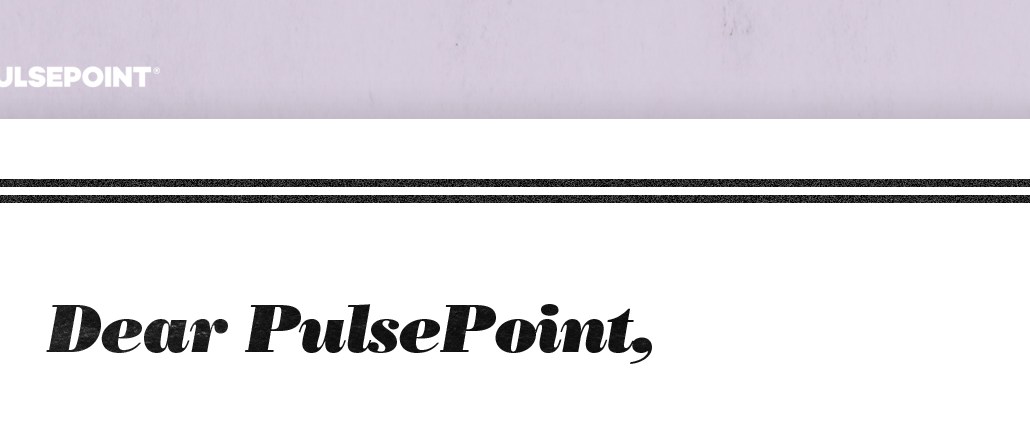Save 50% on a 3-month Digiday+ membership. Ends Dec 5.
Programmatic pro tips: How forecasting can help round up scattered demand

Dear PulsePoint,
Until now, my digital sales process was pretty simple: we’d sell as much direct-sold inventory as we could, aiming for 100 percent, then push the remainder into the private marketplaces and open exchanges. But I think my bottom line is taking a hit – the eCPMs in programmatic are starting to compete with my direct sold eCPMs.
Ever since we started using programmatic, it’s been almost impossible to reserve inventory to meet this higher-priced programmatic demand! So do I miss out on potentially higher revenue to make sure I fill my direct commitments?
Help, PulsePoint! You’re my only hope. How can I get the most bang for my buck out of programmatic selling and more control over my revenue?
With desperation,
A concerned seller
Dear concerned,
Programmatic happened, so let’s not turn back. Try thinking of these new changes the same way I thought about puberty: as an opportunity.
“But how can change be good for business?” I hear you ask. Well, sometimes a little shake up can actually lead you to plan things out, to think before you sell, to forecast. Traditionally, publishers would focus on filling the direct buy and then sell whatever is left programmatically, like you’ve done. But once you pile on the data, targeting and scale infused in daily transactions by impression, marketers pay higher programmatic CPMs, sometimes even rivaling direct sold prices.
So if a unit like outstream video can be sold for more via programmatic than direct, changes have to be made to pick up the extra bucks. Look at header bidding as a tool that will help you make these types of decisions – to evaluate all partners at all times and see when it makes sense to bypass a campaign for higher overall revenue. Suddenly your earning potential is much higher for the same amount of supply – all because you planned and balanced your sales holistically.
And yeah, change is hard. It takes time and effort. But a little spring cleaning can make a big difference. If you’re serious about making this work, there are a few things you can do straightaway.
First, consider how your sales teams (and the ad stacks they’re selling against) are set up. Is there some sort of bias in the selling system that you’re overlooking? Are you still looking at direct and programmatic as separate strategies? Because today, winning back those higher CPMs means breaking down the silos.
Finding the right partner and header bidding solution is key. You don’t have to keep up with the Joneses, running to the shiny new tools that might not be right for you. Don’t have an ops team or a lot of resources to dedicate? Not a problem. Implementing header bidding can be as easy as adding a tag to your header. The key is finding a solution that works best for you and your business needs. Investment in the right technology now, will pay off later.
Finally, prioritize which consumers your direct sales team is approaching. Be very clear with your team about what types of inventory you’re aligning with each sales method – direct, private marketplaces or open auction – and when you’re shifting inventory to fill all commitments. You know you can deliver your direct campaigns over the course of the flight, so if someone is willing to pay more for the same impression programmatically because of header bidding, why turn that offer down?
Trying to jam a square peg down a round hole is not a good look, especially if you’re potentially getting fractions of what you’d be earning in revenue otherwise. It may require you to evaluate some key parts of your revenue optimization efforts but in the end, you’ll be glad you did.
Take a look around. Learn from what your peers are doing. And then do it better.
More from Digiday

Overheard in the Media Agency Report: How Assembly, IPG, Horizon and others use AI and will spend on ads in 2026
In this is behind-the-scenes look at Digiday’s 2025 Media Agency Report, ad execs discuss how the GDP and international sports could impact 2026 spend and how agencies and their clients are actually applying AI tools.

Instacart tripled its smart cart store count this year
Instacart’s smart carts are in triple the number of stores this year than they were in 2024, the company told Modern Retail.

Future of Marketing Briefing: The tells and flops that will define Omnicom-IPG mega holdco
The real story will sit in how this newly fused entity behaves — whether it breaks from the patterns that defined both parents or simply scales them.





